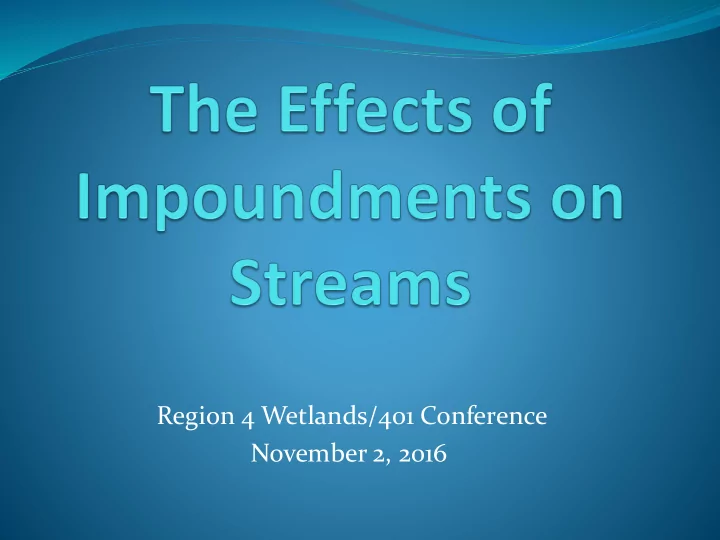

Region 4 Wetlands/401 Conference November 2, 2016
Summary of 2012 Work Temp increased downstream Chl-a increased downstream Invertebrate community more tolerant (BI about 1.5 greater) downstream Possible invertebrate community shifts
Why Another Study? Can impacts be recreated? Better quantification of biological impairment How far downstream to recover from these impacts?
Study Design 13 Lakes (8 Small, 5 Large, 7 Mountain, 5 Piedmont, 1 Sandhills, 1 Urban) 5 sampling locations/ lake/stream Small streams (site 1 < 3 mi 2 watershed) sampled May – June using Qual 4 method Large streams sampled July – Aug using Full Scale Chl-a sampled as well as usual parameters (DO, Temp etc)
Location of Study Sites
Results - Temperature Mean Temperature by Distance Downstream (mi2) Upstream Dam 0.25 0.5 1 2 3 10 25 24 23 Temperature oC 22 Small Stream 21 Large Stream 20 19 18 17
Results – Chlorophyll-a Chlorphyll- a (ug/l) 1 2 3 4 5 50 45 40 35 Chl-a (ug/l) 30 Large Piedmont 25 Mtns & Small Pied 20 15 10 5 0
Biotic Index Changes Change in Biotic Index by Distance Downstream (mi2) Upstream Dam 0.25 0.5 1 2 3 10 3.5 3 2.5 Change in Biotic Index 2 Piedmont Mountain 1.5 1 0.5 0
Results -EPT Taxa Richness 7 streams EPTS declined 60-75% 3 declined 85%, 2 only declined 33% 4 streams never recovered 5 streams recovered in 1 mi 2 Other 3 streams recovered at 3.5, 4 and 9.5 mi 2
Bioclassification Recovery 7 streams dropped 2 bioclasses, be dam, 3 streams dropped 1 bioclass, 1 dropped 3, 1 dropped 4 6 streams recovered in < 1 mi 2 . 2 in 1-5 mi 2 , Recovery occurred in > 9 mi 2 in 4 streams. Many with the fastest recovery were below smallest impoundments.
River Continuum Concept The RCC predicts how biological communities are modified because of catchment size and energy input. This concept has been tested worldwide and seems to hold true. Headwaters dominated by shredders and few grazers, mid-order streams dominated by grazers, few shredders
Predictions Ponds should cut off flow of leaves so shredders should decline be dam Grazers should be low above the dam and increasing as go downstream Filter feeders should spike below the dam eating periphyton from pond, then decline
Reality - Shredders % Shredders by Site 1 2 3 4 5 25 20 % Shredders 15 Small streams Large Streams 10 5 0
Reality – Filter Feeders % Filter Feeders by Site 1 2 3 4 5 40 35 30 % Filter Feeders 25 Small streams Large Mountain 20 Large Piedmont 15 10 5 0
Reality – Filter Feeders % Filter Feeders by Site 2015 1 2 3 4 5 40 35 30 % Filter Feeders 25 Small streams Large Mountain 20 Large Piedmont Impaired 15 10 5 0
Filter Feeders – More Data % Filter Feeders by Site 2015 + 2016 1 2 3 4 5 40 35 30 % Filter Feeders 25 Small streams Large Mountain 20 Large Piedmont Impaired 15 10 5 0
Filter Feeders vs Chlorophyll % Filter Feeders by Site 2015 + Chlorphyll- a (ug/l) 1 2 3 4 5 2016 1 2 3 4 5 40 50 35 45 40 30 35 Chl-a (ug/l) % Filter Feeders 25 30 Small streams Large Piedmont Large Mountain 20 25 Mtns & Small Pied Large Piedmont 20 15 Impaired 15 10 10 5 5 0 0
Water Quality impairment at work? Large Piedmont sites 2, 3 and ½ of 4 Not Supporting Filter Feeders are a relatively intolerant group – mean TV 3.91 Only 5 FF make up impaired community mean TV 6.5 Range 4.9 ( Simulium ) to 7.9 ( Hydropsyche betteni )
Conclusions Are there downstream impacts of impoundments? YES! How far downstream do the impacts go? It depends Temperature – 5-8 o jump be dam, cools by ½ mi 2 to warmer normal Chlorophyll- a – slight increase in Supporting streams, big spike in Not Supporting for 2-5 mi 2 downstream Bugs BI – 1.5-3 unit increase be dam. P streams recover in 3 mi2, M streams drop ½ spike in 0.25 mi 2 then stays
Conclusions (Cont) Bugs EPTS – declined 24-88% be dam, 5 recover in 1mi 2 Bugs Bioclassification – declined 1-4 bioclass be dam ½ streams recovered >1mi 2 , 1/3 unrecovered at 9mi2 Shredders - drop to 5% be dam, slight, incomplete recovery Grazers - respond to reach specific light not impound Filter Feeders – Mountain streams small Piedmont peaked be dam, grazed down pool phyto. Large Pied behaved like impaired, little grazing lots of chl- a
Recommendations Dams are bad for streams. Don’t permit any you don’t have to. Consider requiring mitigation for impaired functions below dam. Maybe for ½ - 1 mi 2 Dam removal companies will want extra mitigation credits. Should they get them?
Recommend
More recommend